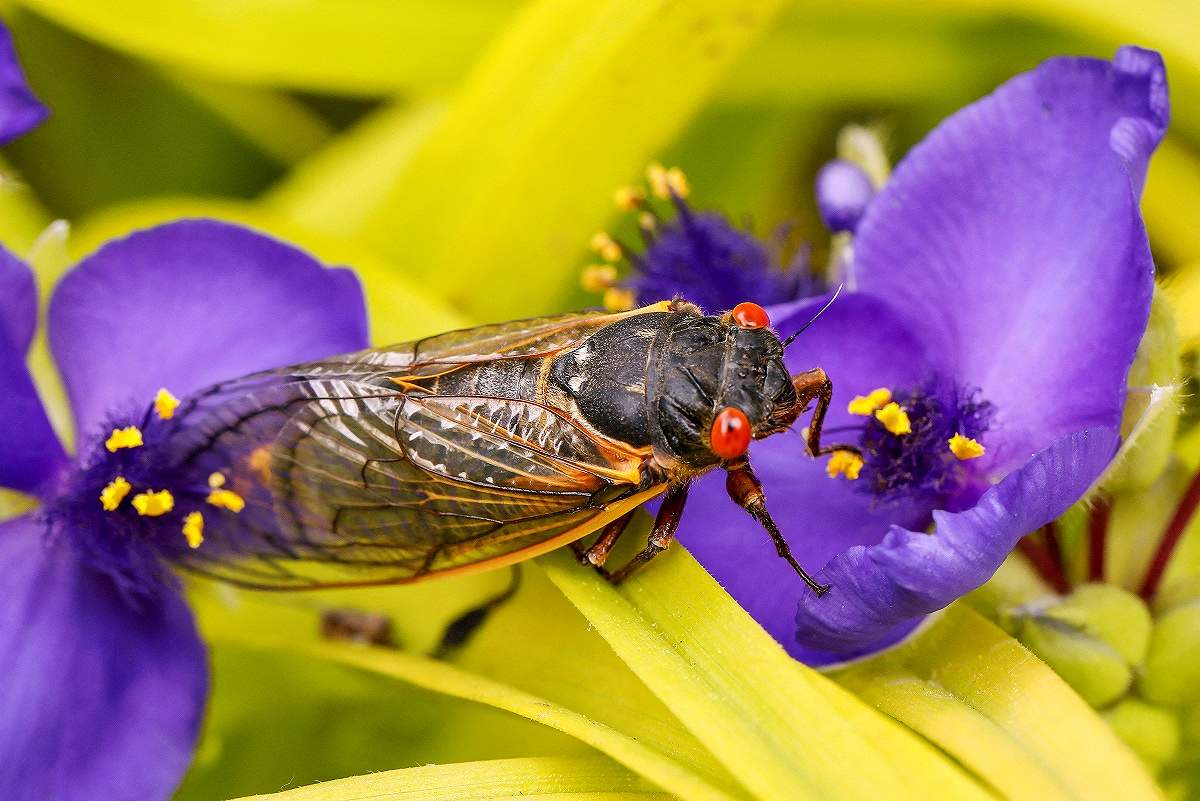
A cicada from Brood X clings to a flower after emerging from its 17 years underground to join the trillions of cicadas that will surface in eastern states in the coming weeks, in Falls Church, Virginia, in May 2021.
13:47 JST, April 11, 2024
Cicadas, the noisy but rather tame insects that spend most of their lives underground, are poised to put on quite a show starting this month in a wide swath of the United States.
Two sizable adjacent broods of periodical cicadas — the kind that spend a specific number of years underground as nymphs before popping up together for a brief bacchanalia of singing and mating — are set to emerge simultaneously, one concentrated in Midwestern states and the other in the South and Midwest.
These two broods — one on a 17-year cycle and the other on a 13-year cycle — together span parts of 17 states. And, according to experts, they will number more than a trillion.
“They live as adults for just a few short weeks and then die after reproducing. In total, the adult portion of their extremely long lives is less than 0.5% of their total life — 99.5% of their life is spent underground,” George Washington University entomologist John Lill said.
These two broods emerge together only once every 221 years, last occurring in 1803. While nymphs in small numbers already are being spotted, the first big wave in the coming weeks is expected in the southernmost areas of the broods in Louisiana, Mississippi, Alabama and Georgia, with the cicadas further northern emerging in subsequent weeks. The last cicadas in these broods will be lucky to see July.
“This is the first time these two broods are going to be emerging in the same year since Thomas Jefferson was in the White House and the same year as the Louisiana Purchase,” said entomologist Floyd Shockley of the Smithsonian’s National Museum of Natural History, referring to the huge U.S. land purchase from France, some of which is inhabited by these two broods.
Cicadas are relatively large insects — 2.5-5 centimeters long — with sturdy bodies, bulging compound eyes and membranous wings.
The 17-year cycle Brood XIII is found in northern Illinois, eastern Iowa, southern Wisconsin and a few counties in northwestern Indiana. The 13-year cycle Brood XIX is distributed in Alabama, Arkansas, Georgia, Indiana, Illinois, Kentucky, Louisiana, Maryland, Missouri, Mississippi, North Carolina, Oklahoma, South Carolina, Tennessee and Virginia.
“There’s nowhere else in the world where it’s possible to see anything at all like this, so I always counsel people to treat them with the respect and awe due to such remarkable creatures,” said University of Connecticut evolutionary biologist John Cooley.
There are more than 3,000 species of cicadas globally. Only nine are periodical, and seven of those are found in North America.
“I find them delightfully awkward, as they are not particularly agile fliers. I also find them captivating and endearing. They are very gentle, and I also find them quite beautiful with the deep red eyes, bluish black body, and the orange wings,” Shockley said.
While underground, nymphs feed on plant juices from the roots of deciduous trees and shrubs. They begin emerging, mainly at night, once the soil reaches a certain warmth, crawling up hard surfaces — tree trunks, telephone poles, fences, trash cans and more — and molt into adult winged cicadas.
Adult males “sing” to attract females using special organs on the abdomen. Females that are attracted to a particular male’s call respond with wing flicks, which also make a sound. Pairs then mate.
This year marks the first time since 2015 that a 13-year brood emerges at the same time as a 17-year brood, though those were not adjacent.
Some people do not share the fondness for cicadas expressed by the scientists, instead finding them icky and gross.
“Insofar as cicadas and their place, they are making a living, just like everything else,” Cooley said. “The species have a long history — millions of years. And that history is much longer and deeper than the history of the landscapes and forests in which they live — on the order of tens of thousands of years. So the cicadas are a natural part of the ecosystem.”
"Science & Nature" POPULAR ARTICLE
-

Genome Study Reveals Milestone in History of Cat Domestication
-

Big Leap in Quest to Get to Bottom of Climate Ice Mystery
-

Japan Set to Participate in EU’s R&D Framework, Aims to Boost Cooperation in Tech, Energy
-

Paws on Parade: Nairobi’s Dogs Dazzle at ‘Pawchella’
-

Japan’s H3 Rocket Failed in Latest Launch, Says Official
JN ACCESS RANKING
-

Tokyo Economic Security Forum to Hold Inaugural Meeting Amid Tense Global Environment
-

Keidanren Chairman Yoshinobu Tsutsui Visits Kashiwazaki-Kariwa Nuclear Power Plant; Inspects New Emergency Safety System
-

Imports of Rare Earths from China Facing Delays, May Be Caused by Deterioration of Japan-China Relations
-

University of Tokyo Professor Discusses Japanese Economic Security in Interview Ahead of Forum
-

Japan Pulls out of Vietnam Nuclear Project, Complicating Hanoi’s Power Plans






















